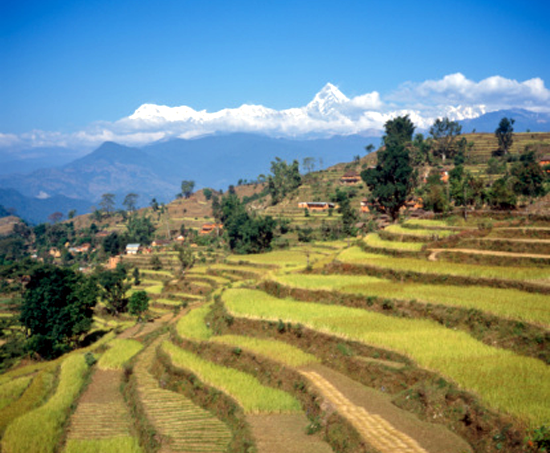Nov 08, 2025
Nov 08, 2025

The Annapurna range of mountains towers over fertile hillsides and valleys
of the Himalayan foothills where crops such as rice are grown on carved out terraces.
Himalayan region is most sensitive as far as the climate change is concerned. It can be termed as the thermometer of climate change. The impact of global warming is visible in the region in some form or the other. The flowers that used to bloom in March have now changed their pattern and come to life in late January. As a child I remember during our annual summer trips to Nainital, there used to be a cold blast from the lake side the moment the car entered the town and we used to shiver even in our pullovers! But now no one needs to wear a sweater and instead of shivering one looks for a shade during day time.
Still better examples of change of climate as the locals have perceived have been worked out by Pashupati Chaudhary and Kamaljit S. Bawa of the University of Massachusetts, Boston, USA and Suman Rai, Siddhant Wangdi, Akai Mao, Nishat Rehman and Santosh Chettri of Ashoka Trust for Research in Ecology and Environment (ATREE), Bangalore, India.
The Himalayas constitute one of the 34 global hotspots of biodiversity and are the source of eight largest rivers in Asia. They constitute a watershed for the land masses of China, India, Pakistan, Bangladesh, Bhutan, Myanmar and Nepal which impacts a large chunk of the world population. Thus the consequences of climate change on biodiversity, agriculture as on human well-being are likely to be severe say Pashupati Chaudhary and co-workers.
Climate change affects in many ways. In a visible form it leads to sudden downpours and flash floods and severe droughts. Both of them have their own ramifications in terms of loss of life and financial terms. However, in addition to these, there are incipient effects too. For example the bio-diversity thriving on a particular climate may feel the brunt of the phenomenon and there could be shifts in geographical ranges of species, alternations in species composition of communities, and even extinction of species.
Change in climate not only affects the flora, it also affects the fauna. For example till late sixties mosquitoes were unheard of at Almora, a ridge town at an altitude of approximately 5000 feet. Now one has to use mosquito repellents/nets to keep off the pests.
So sensitive is the Himalayan eco-system that even minor change of climate produces adverse effects. Pashupati and his co-workers inform that the rate of change is more rapid than the scientific research being carried out on the issue. Local communities on the other hand have been coping with the change in environment since ages and have developed considerable knowledge and skill to cope with the impact of changing climate. Their experience is quite useful for the scientific community and it can be confirmed after scientific experimentation and documented for the posterity. It is easier said than done to collect information from local communities and then test it on scientific merit. These researchers selected Kanchenjunga region to collect data on the local knowledge about the impacts of climate change and their methods of meeting the challenge. The survey involved meticulous collection of data from 576 households in an inhospitable terrain.
The survey showed that the local communities have considerable knowledge about the climate change and they take preventive measures learnt by experience. For example, local observations show that there is a change in pattern of cropping time and an increase in the number and variety of pests and weeds. Certain crops like cauliflower, cabbage, chilli, tomatoes, ginger, winter potato, onion, radish, carrot, beat; millet, wheat and cardamom unheard of being grown in high altitudes are now being cultivated by locals with ease. While this brings about a change in the eating habits of the local people and also augments their income, the change also invites new pests and other vector borne ailments in humans. But yes the climate change has certainly enhanced the economies of such areas.
The concept of climate change in the minds of people may have been a recent phenomenon, but the fact is that for past 18000 years the temperature has been constantly rising. Eastern Himalayas have shown that temperature has been increasing annually by 0.01-0.040C in winters. Quoting other workers like Shreshtha and Bawa, Pashupati et al state that the temperatures in the entire Himalayas have been rising @ 0.060C per year. Similarly an increase in annual rainfall by 18% is postulated by the researchers by the middle of century and 13-14% by the end of the century. Winter snowfall has also increased accordingly and it is 22-35% compared to 17-28% of summers.
An creased rainfall in the mountains means more water in the rivers and also more possibilities of mass wasting due to lubrication of slopes by water. Readers are well aware of the consequences of floods and landslides. The latter also impact the agriculture of high altitudes as most of the terraced fields are washed out by landslides.
Warming of winters causes many animals, birds and trees to migrate to higher altitudes. This impacts the ecosystem at their original site and also at the new site they have migrated to. Since all the animals including man and plants are all interconnected, such shifts sometimes hit the mankind adversely.
Time is ripe for documentation of local knowledge recommends Pashupati et al. They have proved that the local knowledge about the climate change is in conformation with the scientific observations all over the region. Documentation will help the specialists to grow crops suiting the climate and help to tide over the crisis due to climate change. Apart from crops it will also help in making safer development plans so that the landslide hazard is mitigated before it occurs.
Image (c) Gettyimages.com
04-Sep-2011
More by : V. K. Joshi (Bijji)